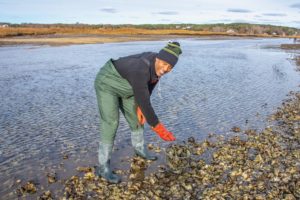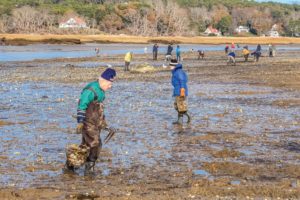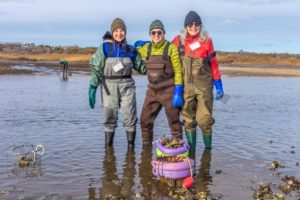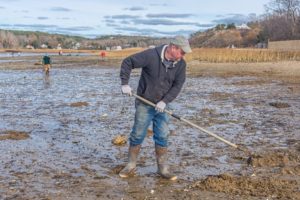TRURO — Recreational shellfishing opened for the season at Pamet Harbor on Dec. 4 after a month of delays due to water quality issues. The water had tested high for fecal coliform bacteria until it finally passed muster with the state’s Div. of Marine Fisheries (DMF) on Dec. 1.
Pamet Harbor is classified as conditionally approved because of the inconsistency of its water quality. Coliform bacteria — mainly the result of the large bird population in the area — is the concern, said Truro Shellfish Constable Tony Jackett.

This means that even after the season opens the state can still close the area if there is a high risk of contamination, which can happen after a day or two of rain, Jackett said.
The harbor typically stays on the warm side into November, which promotes bacterial growth, he said.
Jackett works with the DMF to collect water samples monthly from November through April. In November, samples were tested every week because the town wanted to open shellfishing in Pamet Harbor as early as possible, he said. Samples are collected from eight spots in the harbor and tested at the division’s lab in New Bedford.
The DMF also tests the shellfish meat itself for bacteria. Jackett said that, as of October, the clams in Truro were safe to eat, but Pamet Harbor was still closed because of high water temperatures.
Recreational shellfishing along the rest of the bay shore of Truro is approved year-round, Jackett said.

It was sunny and mild on Pamet Harbor’s long-awaited opening day, and some 70 recreational license holders clad in waders turned out for the 2:24 p.m. low tide to rake in their suppers. Jackett loaned the crowd metal gauges that indicate minimum harvestable shellfish measurements: oysters must be at least three inches long, and quahogs must be at least one inch thick at the hinge.
Ann Kurland, a part-time Truro resident who also lives in Boston, said that Pamet oysters are something special. “The oysters in Truro are particularly plump and have a unique flavor,” she said. “It’s a whole different terroir than Wellfleet,” where she said the oysters are “smaller and brinier.”
Lynn Bowman and Damon Mayers, part-time Truro residents for 25 years before relocating full-time in October, have long enjoyed harvesting oysters in Pamet Harbor. Mayers is retired from the restaurant industry and plans to make oysters Rockefeller with any of the bivalves he and Bowman don’t eat raw.
In Truro, annual recreational licenses are valid starting Nov. 1 and are free for residents over 62 years old, $15 for residents under 62, and $100 for nonresidents. There is also a weekly permit available to nonresidents for $25. A recreational license allows the holder to harvest one 10-quart pail per week, including oysters and quahogs but also soft-shell clams, razor clams, sea clams, and blue mussels, all of which are found in Truro waters, according to the town’s website.
Not all of them are wild. The town purchases seed each spring from the Aquacultural Research Corp. in Dennis, which Jackett spreads in the harbor. Their presence helps induce adult oysters to spawn, said Jackett, which happens when the water warms to 68 degrees — usually in early July.

Dana Pazolt of Truro was at Pamet Harbor on Sunday with his recreational license, but he is also a commercial fisherman. He sets his 800 lobster traps on the ocean side, and he currently has one of seven commercial shellfishing licenses in town.
Pazolt’s oyster farm is located at the Sea Gull Motel landing and spans two acres. Pazolt said he is currently growing millions of oysters on his grant. He sells to Cape Tip Seafood in Provincetown, he said, where owner Chris King was his elementary school classmate.
Last year, Pazolt also sold some oysters to the town. The town’s purchase of shellfish from local growers was made possible because of a $10,000 Covid-19 relief grant from a National Oceanic and Atmospheric Administration-funded Woods Hole Sea Grant program administered by the county’s extension service. Jackett’s department bought 4,000 oysters for $2,000 from Pazolt to place in Pamet Harbor. It also bought 12,000 oysters from Steve Roderick for $6,000, and the remaining $2,000 went to Orion White for oyster seed.
The other two-acre tidal area allocated for commercial shellfishing in Truro is at the town landing adjacent to Top Mast Resort, Jackett said. Dan Smith, chair of the Truro shellfish advisory committee, has that grant.

Truro also has an Aquaculture Development Area (ADA), which is 25 acres in the bay and the site of five commercial licenses. Each license grants access to a five-acre area, but unlike the flats the ADA is subtidal and accessible only by boat. Both Roderick and White, from whom the town purchased oysters and seed using Sea Grant funds, have commercial grants in the ADA.
To receive a commercial license for the ADA, applicants must specify the types of shellfish they plan to raise, their plan for propagation, their means of access, and what equipment they plan to use.
All five of these grants have been licensed, but the father and son duo Billy and Jeffrey Souza made the decision this year not to renew theirs. The Souzas are also commercial lobstermen, and Jeffrey catches tuna, Jackett said.
“When it comes time to renew the grant, you’ve got to stay active,” said Jackett. After five years, the Souzas chose to focus on their other fishing endeavors.
On Dec. 13, there will be a public hearing on the application of Douglas Grey of Truro to become the next ADA grant holder. He had been on the waitlist and got a call when the Souzas opted not to renew. If he gets the license, this will be his first experience with commercial shellfishing, said Jackett.
“It’s more a labor of love for these guys,” he added.



